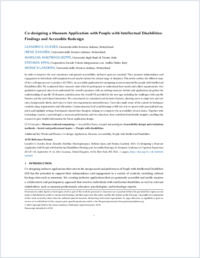Co-designing a museum application with people with intellectual disabilities : findings and accessible redesign
- Soares Guedes, Leandro ORCID Istituto Dalle Molle di studi sull'intelligenza artificiale (IDSIA), Facoltà di scienze informatiche, Università della Svizzera italiana, Svizzera
- Zanardi, Irene ORCID Istituto Dalle Molle di studi sull'intelligenza artificiale (IDSIA), Facoltà di scienze informatiche, Università della Svizzera italiana, Svizzera
- Mastrogiuseppe, Marilina Università degli Studi di Trieste, Università degli Studi di Trieste, Italy
- Span, Stefania Cooperativa Sociale Trieste Integrazione a m. Anffas Onlus, Cooperativa Sociale Trieste Integrazione a m. Anffas Onlus, Italy
- Landoni, Monica ORCID Istituto Dalle Molle di studi sull'intelligenza artificiale (IDSIA), Facoltà di scienze informatiche, Università della Svizzera italiana, Svizzera
- 2023
Published in:
- European Conference on Cognitive Ergonomics (ECCE). - 2023, p. 1-8
English
In order to improve the user experience and general accessibility, inclusive apps are essential. They promote independence and engagement in individuals with impairments and may be tailored for a broad range of situations. This article outlines the different steps of the co-design process to produce ACCESS+, an accessible application for navigating museum material for people with Intellectual Disabilities (ID). We conducted three research visits with 20 participants to understand their needs and collect requirements. Our qualitative approach aims to (i) understand the overall experience with an existing museum website and application; (ii) gather the understanding of specific UI elements; and (iii) assess the overall UX provided by the new app, including the challenges with specific features and the touch-based interaction. We concentrated on customized and inclusive features, allowing users to adapt icon and text sizes, backgrounds, labels, and voices to their own requirements and preferences. Users also made sense of the content by looking at symbols using Augmentative and Alternative Communication (AAC) and listening to full-text text-to-speech with personalized tone, pitch, and highlight settings. Participants shared their thoughts, helping us to improve the accessibility of each choice. Together with technology experts, a psychologist, a museum professional, and two educators, they contributed invaluable insights, enabling this research to give helpful information for future application design.
- Collections
- Language
-
- English
- Classification
- Computer science and technology
- License
-
Rights reserved
- Open access status
- green
- Identifiers
-
- DOI 10.1145/3605655.3605687
- ARK ark:/12658/srd1328205
- Persistent URL
- https://n2t.net/ark:/12658/srd1328205
Statistics
Document views: 147
File downloads:
- SoaresGuedes_2023_ECCE: 323
